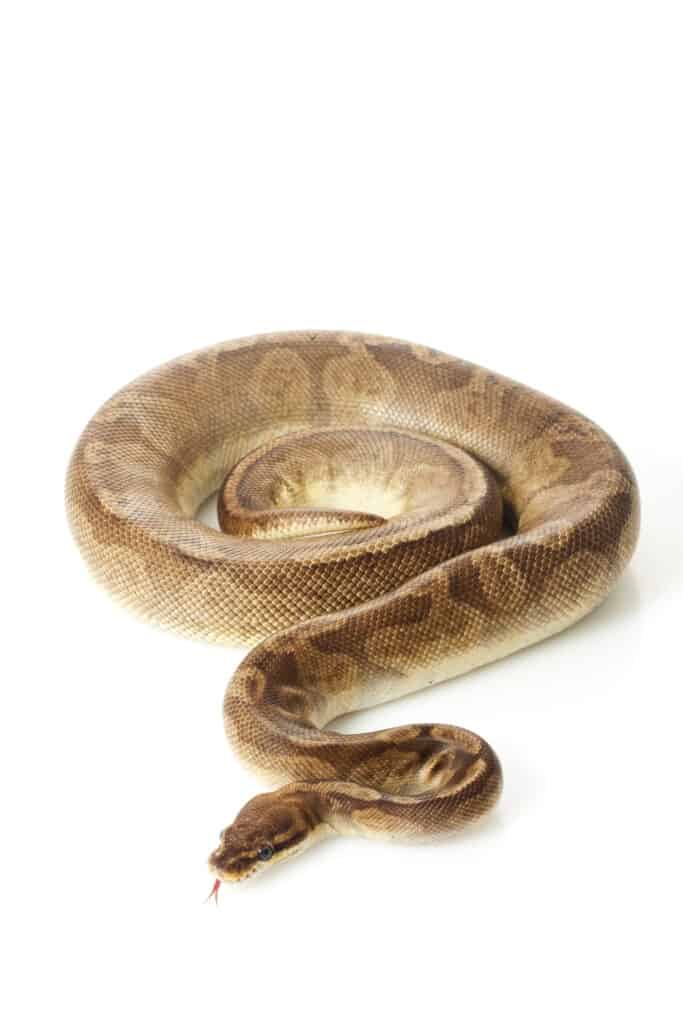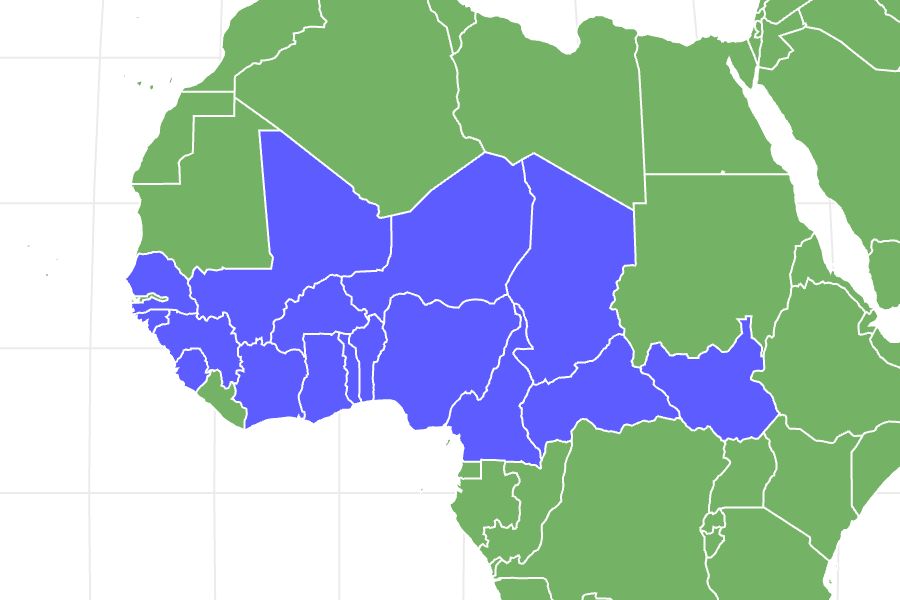Sunset Ball Python
Python regius
Sunset ball pythons are bred with several other morphs to get designer colors.
Advertisement
Sunset Ball Python Scientific Classification
- Kingdom
- Animalia
- Phylum
- Chordata
- Class
- Reptilia
- Order
- Squamata
- Family
- Pythonidae
- Genus
- Python
- Scientific Name
- Python regius
Read our Complete Guide to Classification of Animals.
Sunset Ball Python Conservation Status
Sunset Ball Python Facts
- Prey
- Small rodents, birds, lizards
- Main Prey
- Rodents
- Name Of Young
- Hatchling, snakelet
- Group Behavior
- Solitary except during mating season
- Fun Fact
- Sunset ball pythons are bred with several other morphs to get designer colors.
- Most Distinctive Feature
- Rusty reds and elongated flame-shaped markings.
- Other Name(s)
- Ball python
- Gestation Period
- 50-60 days
- Diet
- Omnivore
- Lifestyle
- Nocturnal
- Favorite Food
- Rodents
- Origin
- Central and Western Africa
- Number Of Species
- 1
- Location
- Central and western Africa
- Average Clutch Size
- 8
Sunset Ball Python Physical Characteristics
- Color
- Brown
- Red
- Orange
- Chocolate
- Peach
- Golden
- Skin Type
- Scales
- Weight
- 5-6 pounds
- Length
- 4-6
- Age of Sexual Maturity
- 2-5 years
- Venomous
- No
- Aggression
- Low
View all of the Sunset Ball Python images!
The sunset ball python is covered in rust and burnt-orange colors. The first individual was found in Africa as a wild-hatched snake.
This snake is native to central and western Africa, and the primary export countries are Benin, Togo, and Ghana. Now, several breeders incorporate the sunset gene into their programs and produce beautiful snakes that exhibit some of the reds and oranges of the original.
Incredible Sunset Ball Python Facts
- Outback Reptiles imported and sold the first sunset ball python to Brian Barczyk in the early 2000s for $70,000.
- This color morph is a recessive mutation. It’s covered in a rusty, burnt-orange color gradient.
- Sunset genes are used in combination with others like cinnamon, enchi, and banana. The combination produces different patterns and colors.
Sunset Ball Python Scientific Name and Classification
Just like other ball pythons, sunset ball pythons are in the family Pythonidae and their scientific name is Python regius. Their specific name means royal, kingly, or of a king. It comes from a belief that rulers used to wear ball pythons on their wrists, like jewelry. Cleopatra was rumored to have done this.
Ball pythons have a habit of coiling up into a ball, either because they feel threatened or when they need to sleep – hence, their common name.
Sunset Ball Python Appearance

Sunset ball pythons have a beautiful red-orange color palette that doesn’t look much like their normal ball python siblings.
©Fivespots/Shutterstock.com
The ball python is a small to medium-size python that grows to about 4-6 feet long. Females are typically longer and thicker than males. They have a triangular head with blunted snout, and along their upper lips, they have heat-sensitive pits that help them find warm-blooded prey even in the dark. These snakes have vertical pupils and a mouth full of teeth. Their classic pattern has been described as a series of alien heads down the length of the body. While this is certainly one way to describe them, their markings can vary widely and even be almost completely absent in some individuals.
Sunset Ball Python Color Morph
Sunset ball pythons have a beautiful red-orange color palette that doesn’t look much like their normal ball python siblings. The head of a sunset can be anything from a deep tan to chocolate brown. The markings are more stretched out and look more like candle flames or even banding. Their color begins as a side flaming in bright orange close to the belly and becomes dark brown toward the dorsal stripe, which often has a bubble-like pattern.
Some color morphs like the sunset are naturally occurring mutations that breeders like Brian Barczyk are waiting to find. His video on some of the history of the growth of the ball python pet trade is really informative. Breeders actively seek out natural mutations like this one. It’s how they inject fresh genes into their lines and create designer ball pythons. These morphs come in colors and patterns like the banana, spider, and yellow belly.
The first snake with this color pattern originated in Africa. U.S. breeder Brian Barczyk got a phone call from a trader there, telling him about a fantastic new ball python color. This isn’t always the case, but Barczyk requested photos anyway. When he saw the photos, he was shocked to see that this snake was really different than anything he’d seen before. He paid Outback Reptiles $70,000 to purchase the snake and have it imported.
Sunset Ball Python Behavior
Sunset ball pythons, like other ball pythons and their morphs, make excellent pets. These snakes are docile and tolerate gentle handling pretty well. They’re also easy to care for; once you have a habitat set up for your snake, need very little aside from fresh water and food.
They’re nocturnal and spend most of their time hidden somewhere. Some people call these snakes the packrats of the snake world because they prefer a lot of clutter in their habitat. These snakes use their camouflage to move underneath the grasses and leaf litter. They stay hidden in abandoned burrows, under old logs, and anywhere else that gives them a snug little spot to feel safe.
As pythons, they’re nonvenomous constrictors that squeeze their prey until its heart stops. Then, they can swallow it whole without worrying about it escaping. These ambush predators don’t do a lot of active hunting. Instead, they wait for their meal to wander close enough to grab.
Sunset Ball Python Habitat and Diet
In the wild, ball pythons live in open grasslands, forests, and agricultural areas. In Central Africa, they’re found in 17 countries. Burkina Faso, Cote d’Ivoire, Central African Republic, DR Congo, Guinea-Bissau, Guinea, Senegal, Sierra Leone, Mali, Ghana, Togo, Benin, Niger, Nigeria, Cameroon, Chad, and South Sudan are all part of their range.
They have a cryptic pattern that incorporates browns, yellows, and greens into the alien head shapes. It allows them to camouflage in the dense underbrush of their native environment.
Their diet in the wild includes any small warm-blooded animal that they can overpower, primarily rodents and birds. In captivity, most of them are happy to take rats or mice every other week or so. However, they’re known for going on months-long hunger strikes with no ill effects.
Sunset Ball Python Predators, Threats, Conservation, and Population
Natural predators abound for these snakes. They’re not large pythons, and of course, they’re nonvenomous. Any predator large enough would be likely to go after one. This could include everything from mongooses to king cobras and birds of prey.
Sunset ball pythons are still gaining in popularity in the pet trade, but not too many breeders are doing a lot with them yet. It’s likely that they’re just too new of a gene set, and it’ll take time to have enough of them in circulation. The first one was found in Africa as a hatchling and imported by Outback Reptiles. It’s likely that there are more of them out in the wild, but it’s impossible to tell for sure.
However, the overall ball python population is declining in the wild. The species is under tremendous pressure from numerous sources. Locals hunt them for food, skin, and traditional medicine. Excessive pet trade export and agricultural expansion may also damage the wild population. Ball pythons are exploited more heavily than any other snake species, according to the IUCN Redlist of Threatened Species assessment. If the present trends continue, it’s possible that the ball python may become endangered in West Africa.
Sunset Ball Python Reproduction, Babies, and Lifespan
Like other ball pythons, sunset ball pythons can live for 20-30 years in captivity. After successful mating, females lay 3-15 eggs. They coil around their eggs until they hatch, about 50-60 days later. Sometimes they leave the eggs to bask and warm up or allow the eggs to cool a bit if the weather is too warm.
Breeding the sunset ball python wasn’t initially successful. Barczyk originally believed that it was a dominant trait, and bred the first snake with several normal ball pythons. Those clutches produced all normal ball pythons – no sunsets. He sold them all as normal, so there may be a few hidden sunsets waiting to be discovered, but time will tell.
It wasn’t until later that the recessive nature of the gene proved itself, and breeders began to have success producing sunsets and mixes with other morphs.
Next Up
View all 293 animals that start with SSunset Ball Python FAQs (Frequently Asked Questions)
Are sunset ball pythons good pets?
Yes, like other ball pythons, they’re pretty easy to take care of and make terrific beginner snakes.
Are sunset ball pythons aggressive?
Not usually, they can be a little snippy when they’re younger but generally mellow out as they age.
What do sunset ball pythons eat?
All ball pythons eat primarily rodents, but will also eat small birds and lizards.
How do sunset ball pythons hunt?
They’re classic ambush predators, these snakes aren’t very active and wait for their food to stumble close enough to grab.
Are sunset ball pythons venomous?
Not at all! These are nonvenomous constrictors that squeeze the life out of their prey before swallowing it whole.
Thank you for reading! Have some feedback for us? Contact the AZ Animals editorial team.
Sources
- Sunset Bal Python | Morph Market, Available here: https://www.morphmarket.com/morphpedia/ball-pythons/sunset/
- D'Cruze, N., Wilms, T., Penner, J., Luiselli, L., Jallow, M., Segniagbeto, G., Niagate, B. & Schmitz, A. 2021. Python regius. The IUCN Red List of Threatened Species 2021: e.T177562A15340592. https://dx.doi.org/10.2305/IUCN.UK.2021-2.RLTS.T177562A15340592.en. Accessed on 19 August 2022., Available here: https://www.iucnredlist.org/species/177562/15340592
- Python regius | Reptarium Reptile Database, Available here: https://reptile-database.reptarium.cz/species?genus=Python&species=regius

















